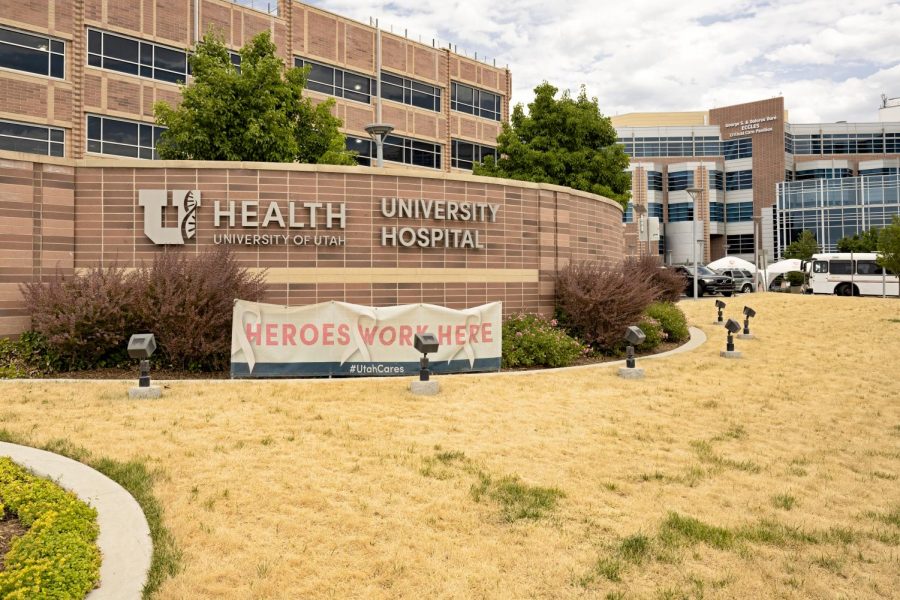COVID-19 Alters Pre-Med Experience, Increases Stress
University of Utah Hospital main entrance in Salt Lake City on June 23, 2021. (Photo by Kevin Cody | The Daily Utah Chronicle)
October 22, 2021
For many undergraduate students, getting a bachelor’s degree means being able to apply to professional schools, including medical school. According to the Association of American Medical Colleges, an organization that compiles yearly medical school admissions statistics, the 2020-2021 application cycle saw a total of 53,030 medical school applications with only 23,105 applicants admitted to schools, just 43.6% of the total.
Academic performance, gaining clinical experience, research and extracurricular activities have all been important factors historically in a student’s admission to medical school, but many of these opportunities have been altered if not canceled during the COVID-19 pandemic.
Eliza Steinberg, a third-year pre-med student at the University of Utah, knows the anxieties of preparing for medical school during a pandemic first-hand.
“Interestingly, COVID-19 has actually increased my desire to be in the medical field,” Steinberg said. “It really showed me the importance of having the medical knowledge that doctors and nurses have.”
Like many pre-meds, Steinberg has sought out extracurricular experiences only for COVID-19 restrictions to alter them.
“I joined a pre-med club last year, which was right at the start of COVID-19,” Steinberg said. “Right away, it wasn’t the best experience because it wasn’t in person. It was hard to meet new members and really feel like a part of the team.”
COVID-19 has also affected the availability of specific medical experiences that were once commonplace for pre-meds.
“I would like to go out and get more clinical experience in a variety of settings, but that wasn’t really an option for a long time,” Steinberg said. “Also, while I was registering for research experience, labs were beginning to shut down. COVID-19 has definitely increased my anxiety because I feel like I’m falling behind.”
According to Shelley Nicholson, director of pre-professional advising at the U, pre-meds feeling additional stress as a result of COVID-19 is not uncommon.
“I think it’s a different kind of stress,” Nicholson said. “School is difficult, and balancing time management is hard. Now add that to the stress of COVID-19. Where my humility comes in is hearing stories from students about what they’ve gone through, and knowing that they still want to go into medicine.”
Nicholson said while their advising is compassionate and empathetic to student challenges, they still encourage students to think big picture.
“Some programs might be a little bit more compassionate about the challenges students face, but they still want students to be competitive,” Nicholson said. “That’s why students need to approach this creatively. For example, maybe you can’t shadow right now. You can show your desire to learn and push through those challenges by maybe doing virtual shadowing. That is an example of creativity. I always tell students that they can do this; just because it’s hard doesn’t mean that they can’t do it.”
Nicholson advises students to be patient, flexible and creative with their plans to enter any professional school, including medical school.
“We all have plans, and plans change,” Nicholson said. “Some students have the idea to be able to graduate in four years and to start medical school right after they graduate. COVID-19 has thrown a wrench into a lot of those plans, and I think it serves as a reminder to students that just because it may take a little bit longer than you initially thought doesn’t mean you can’t do it and be successful.”
Nicholson emphasized that students looking to enter medical school should begin their application preparation early.
“A lot of students want to wait until later in the spring semester, like April or May, to start working on big pieces of their application. Don’t wait on it,” Nicholson said. “I usually encourage students to start working on their applications around winter break. And don’t pursue activities just to ‘check off the boxes.’ Use your service to the community, leadership, shadowing and research to demonstrate who you are and to show medical schools why you want to be a doctor.”
Additionally, Nicholson also recommends that students take advantage of the pre-professional advising available to them.
“We have a lot of resources available through Pre-Professional Advising,” Nicholson said. “There are a lot of workshops and online information where students can, for example, access timelines about the application cycle. Our entire purpose for existing as a pre-professional office is to help students to be competitive applicants and get into professional programs. I want students to realize that they do not have to do this by themselves.”
To schedule a meeting with an advisor like Nicholson, or to view a compilation of online resources from Pre-Professional Advising, visit the Pre-Professional Advising Office at the Academic Advising Center located in Building 44 or their website.
This article was updated on Oct. 26, 2021 to correct a computation error involving U.S. medical school acceptance rate statistics for the 2020-2021 admissions cycle. The acceptance rate was 43.6%, not 2.5%, for the 2020-2021 cycle.








